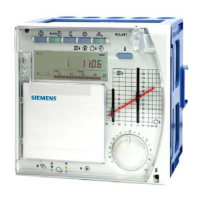40/118
Siemens Heating and D.h.w. Controller RVL481 CE1P2541en
Building Technologies 10 Function block "Space heating" 20.05.2008
t
1
T
Rw
T
RM
T
Rw
T
Rw
2540D02
T
R
t
Progression of room temperature generated by the room model
e 2.71828 (basis of natural logarithms)
k
t
Building time constant in hours
t Time in hours
t
1
Quick setback
T
AM
Composite outside temperature
T
R
Room temperature
T
RM
Room model temperature
T
Rw
Setpoint of NORMAL room temperature
T
Rw
Setpoint of REDUCED room temperature
10.4.5 Optimum stop control
During the building's occupancy time, the RVL481 maintains the setpoint of NORMAL
heating. Towards the end of the occupancy time, the control switches to the REDUCED
setpoint. Optimization calculates the changeover time such that, at the end of occu-
pancy, the room temperature will lie 0.5 °C below the setpoint of NORMAL heating
(optimum shutdown).
By entering 0 hours as the maximum optimum shutdown, optimum stop control can be
deactivated.
10.4.6 Quick setback
When changing from the NORMAL temperature to a lower temperature level
(REDUCED or holidays / frost), the heating will be shut down. And it will remain shut
down until the setpoint of the lower temperature level is reached.
• When using a room temperature sensor, the effective actual value of the room tem-
perature is taken into account
• When using no room sensor, the actual value is simulated by the room model.
The duration is determined according to the following formula:
t = 3 × kt × (ln ) [h]
T
Rw
- T
AM
T
Rw
- T
AM
ln Natural logarithm
k
t
Building time constant in hours
t Duration of quick setback
T
AM
Composite outside temperature
T
Rw
Setpoint of NORMAL room temperature
T
Rw
Setpoint of REDUCED room temperature

